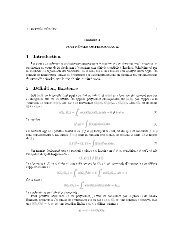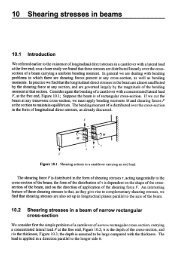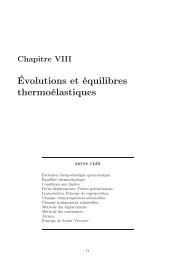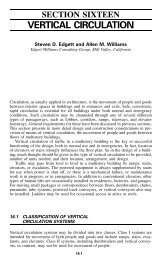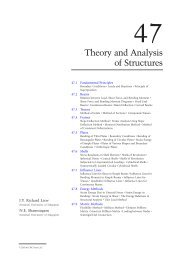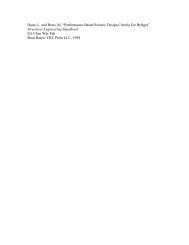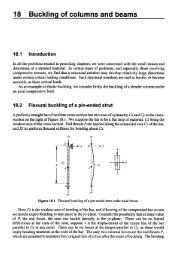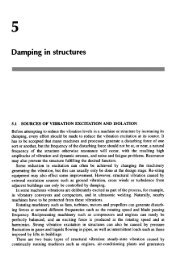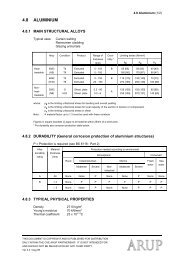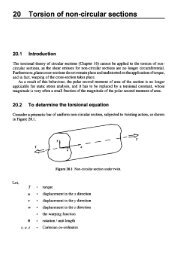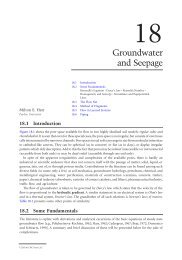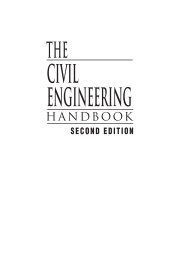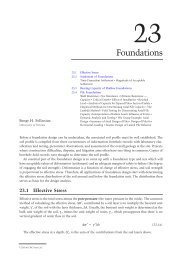Chapter 32 - Deep Foundations - Index of - Free
Chapter 32 - Deep Foundations - Index of - Free
Chapter 32 - Deep Foundations - Index of - Free
- No tags were found...
You also want an ePaper? Increase the reach of your titles
YUMPU automatically turns print PDFs into web optimized ePapers that Google loves.
TABLE <strong>32</strong>.5Typical Values <strong>of</strong> Bearing Capacity FactorN qϕ a (degrees) 26 28 30 31 <strong>32</strong> 33 34 35 36 37 38 39 40N q(driven pile displacement) 10 15 21 24 29 35 42 50 62 77 86 120 145b(drilled piers) 5 8 10 12 14 17 21 25 30 38 43 60 72aLimit ϕ to 28° if jetting is used.b1. In case a bailer <strong>of</strong> grab bucket is used below the groundwater table, calculate end bearing based on ϕ notexceeding 28°.2. For piers greater than 24-in. diameter, settlement rather than bearing capacity usually controls the design. Forestimating settlement, take 50% <strong>of</strong> the settlement for an equivalent footing resting on the surface <strong>of</strong> comparablegranular soils (<strong>Chapter</strong> 5, DM-7.01).Source: NAVFAC [42].N qQ end_maxcN c A pile<strong>32</strong>.4.2 End BearingEnd bearing is part <strong>of</strong> the axial compressive resistance provided at the bottom <strong>of</strong> a pile by theunderlying soil or rock. The resistance depends on the type and strength <strong>of</strong> the soil or rock and onthe stress conditions near the tip. Piles deriving their capacity mostly from end bearing are calledend bearing piles. End bearing in rock and certain types <strong>of</strong> soil such as dense sand and gravel isusually large enough to support the designed loads. However, these types <strong>of</strong> soil or rock cannot beeasily penetrated through driving. No or limited uplift resistance is provided from the pile tips;therefore, end-bearing piles have low resistance against uplift loading.The end bearing <strong>of</strong> a pile can be expressed as:=⎧⎪⎪σ v ′ N q A pile⎨U ⎪----- c⎪ 2 N k A pile⎩for clayfor sandfor rock(<strong>32</strong>.6)whereQ end_max= the maximum end bearing <strong>of</strong> a pileA pile= the area <strong>of</strong> the pile tip or baseN c, N q, N k= the bearing capacity factors for clay, sand, and rockc = the cohesion <strong>of</strong> clayσ′v= the effective overburden pressureUcU c= the unconfined compressive strength <strong>of</strong> rock and Su, the equivalent shearstrength <strong>of</strong> rock2 =ClayThe bearing capacity factorN cfor clay can be expressed asLN = c60 . ⎛1⎝+ 02 . ⎞D⎠ ≤ 9(<strong>32</strong>.7)where L is the embedment depth <strong>of</strong> the pile tip and D is the diameter <strong>of</strong> the pile.SandThe bearing capacity factor N qgenerally depends on the friction angle φ <strong>of</strong> the sand and can beestimated by using Table <strong>32</strong>.5 or the Meyerh<strong>of</strong> equation below.© 2000 by CRC Press LLC



